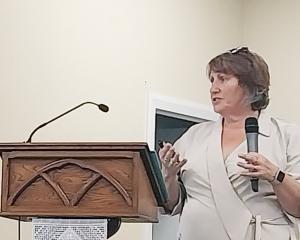The unknown gold miner’s remains were discovered buried near Cromwell in 1983, during archaeological work ahead of construction of the Clyde Dam and highway.
Evidence of grave robbing was discovered which had occurred sometime after his burial more than 140 years ago.
The man’s remains, including his well-preserved boots, were then housed in the University of Otago’s anatomy department where the man was known as "E224".
Attempts in recent years to identify the miner have been in vain.
A push in February for a final resting place for the man now known as "the Gold Miner" culminated in his burial at the Cromwell Cemetery on Saturday in a traditional Anglican service that was taken straight from the Victorian era in which he died.
The service was heavy on symbolism even in the lead-up to his burial, every step paying nod to how things would have been in the mid-to-late 19th century.
The man’s bespoke coffin was carried through Old Cromwell across the town by a horse-drawn hearse to the cemetery, where the miner was given a final resting place.

Affinity owner and fourth generation funeral director Clark Campbell, of Campbell & Sons in Mosgiel, spoke to the Otago Daily Times before taking part in funeral cortege from the Otago Goldfields Heritage Trust headquarters in Historic Cromwell.
Wearing his great-grandfather’s original morning coat and his grandfather’s top hat, he said it represented his own family’s undertaking history.
"He [his great-grandfather] was obviously quite small because this is quite tight and I wouldn’t consider myself large."
Many others in the cortege also donned Victorian garb , including pioneering restaurateur Fleur Sullivan, owner of restaurant Fleurs Place in Moeraki and who runs the Loan and Mercantile in Oamaru.
She has an affinity for Central Otago having set up Olivers in Clyde and she accompanied Mr Campbell on the dray carrying the miner’s casket.

"But he’s going to have one today [something] which all New Zealanders should be entitled to a dignified ceremony and acknowledgement they were on this earth."
At the cemetery, University of Otago bio-archaeologist Prof Hallie Buckley, honorary research fellow Dr Peter Petchey, and Dr Neville Ritchie, who originally discovered the remains, served as pallbearers.
At the service, presided over by the Rev Barry Entwisle, Mrs Claridge said in her address the funeral was an important event for Central Otago against the "backdrop of the goldfields, with everything they brought and took away from our community".
"We’ve heard from many locals whose relatives were lost during those hard times, and for whatever reason, didn’t have the burial they deserved.
"Mr Gold Miner is at rest now, his work is done."












